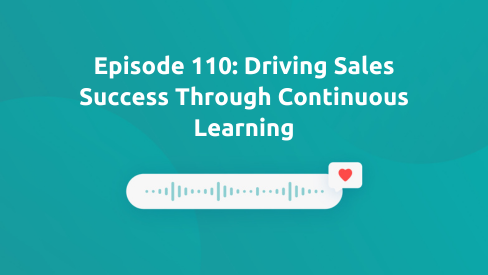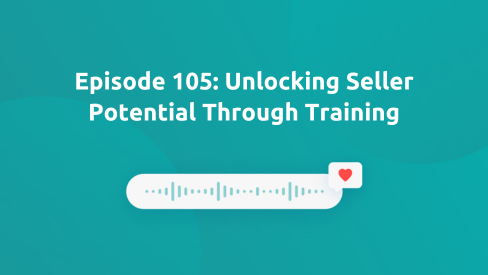According to research conducted by Gartner, B2B sales reps forget 87% of what they learn within 30 days of training. So how can you build effective learning programs that foster continuous development?
Shawnna Sumaoang: Hi, and welcome to the Win-Win podcast. I am your host, Shawnna Sumaoang. Join us as we dive into changing trends in the workplace and how to navigate them successfully.
Here to discuss this topic is Tom Brandon, the Director of Sales Enablement at OneSpan. Thank you for joining us, Tom. I would love for you to tell us about yourself, your background, and your role.
Tom Brandon: Thanks for having me. I’m excited to be here. So I’m Tom Brandon. I’m the director of sales enablement at OneSpan, which is a workforce authentication, banking authentication, and digital agreements company.
I’ve been in the training and enablement field for way too long. I don’t want to say how many years it’s been, but started out as a technical trainer, doing all of the. Microsoft training, MCSC, MCP, MCT, Cisco training, delivering all of those, and eventually became a global trainer for a cybersecurity company, Trend Micro, took on their training teams, took on their development teams, and ran their global education department, was there for about 10 years.
Then moved on to another cyber security company, WebSense, which became Forcepoint, and took on their global education department, and eventually we branched off the sales and technical, and I continued on with their technical education and building out their programs. For almost 10 years as well. Then moved on again to another cyber security company, ReliaQuest, and was their VP of learning at ReliaQuest University.
And then finally here at OneSpan. I’ve been at OneSpan now for about a year and a half, really enjoying working with this company and the sellers and building out a true enablement.
SS: I love that. Well, Tom, thank you again for joining us. You have extensive experience in designing and delivering learning programs. So what are some of your considerations when developing programs for these different teams across go-to-market like revenue and customer success teams?
TB: That’s a great question because each team always has a unique focus and spin that you have to be aware of, but for me it really comes down to five main things.
What do they need to know? Why do they need to know it? When do they need to know it? How do they do it? And then who do they go to for any questions? And so everything that we’re doing focuses on those five main areas. And whether it be a simple microlearning, whether it be a full-fledged training, or it’s a communication that we’re sending out, those are things that I always focus on because.
If a sales rep or a customer success manager doesn’t know why a change was implemented or why pricing has gone up or when things go into effect or how to actually do something for our PS and our SE organizations, then they’re at a disadvantage and they’re not going to look good in front of their customers.
So those are the things that I usually focus on. Anytime we’re building out any type of communication enablement or training program.
SS: I think that’s great advice. Now, one thing that did catch my eye on LinkedIn was that you mentioned you actually rebuilt the onboarding program at one span to a flipped classroom model. For those that are maybe a little less familiar, can you explain what a flipped classroom model is? And can you tell us more about this effort and how your team brought it to life?
TB: Absolutely. In traditional education, think about when you’re going to a university course, you go into the lecture and you have the professor that’s up there and they’re delivering their lecture content.
They probably delivered that hundreds of times for different classes. And it’s the exact same thing every time. And the students, then they take that information and then they go and they have to read some more. They have to do some worksheets and everything. And it’s It’s a one way data transfer, and it’s really not a great way for the students to learn and apply that information.
Whereas with the flipped classroom, the idea is that you give the students content ahead of time. You give them all of that, that learning, that book study that they need to be doing, and they prepare for the in-class session with all of that content. Now, when they’ve done that, the time with that expert, with that SME, now can be used for deeper engagement, for communication, for role plays, for a practical application of that content that they have just read about and they’ve gone through all that self-paced learning.
And then after class, this is where they can do some additional application of what they have practiced. in class, whether they have discussion forums or assessments or additional learning opportunities. And so it’s a way to not only get the information across, but have a two way communication with the students, which is going to help them to remember the content.
It also allows them an opportunity to practice in a safe environment and then gives them further opportunities outside of class to apply that knowledge.
SS: Amazing. Well, I think it’s really cool what you guys are doing on that front. And you actually leverage the certifications in your onboarding program, as well as other ongoing learning programs. How have you used certifications to motivate learners and validate skills?
TB: Well, the validation, that’s the easy part, right? That’s what certifications are all about, is validating that somebody knows a fact or is aware of a process or whatever it may be. The motivation, that’s the hard part, is trying to figure out how you can not only validate or assess but also get people excited about what they are learning about.
And this is really where things like setting up achievements for people, having specific goals that they can achieve, and then having some sort of reward for them, whether it’s digital or physical, whatever it might be. And this is also where you can start talking about. The idea of gamification or serious gaming as well.
For me, I’ve never been a big one on gamification. Let’s just put something into a game just so that people will go through the content and the game has nothing to do with the content that they’re going through. But serious gaming, something that is a practical application, something that is an experiential-based learning opportunity for them that then gives them an achievement once they have actually shown that they can perform some action, whether it’s delivering a pitch or whatever it might be.
But It shows them that they can be confident in what they are learning, that they are actually making progress and achieving. And so, you know, for me, it’s finding ways that you can do this serious gaming and provide achievements along the way.
SS: I absolutely love that. Definitely, progress is a motivator, I think, for a lot of people. As you think about reps or go-to-market teams, oftentimes they are on the move and extremely busy. So how do you incorporate microlearning and agile curriculum methodologies into your learning programs?
TB: We have all seen a decrease in our attention spans over the last several years. We’re so used to the quick hits and ever-changing content that’s put in front of us by social media that the traditional approach To lengthy training programs is not appropriate for our current audiences.
And so, looking at, one, an agile development framework is absolutely important, because if you look at the traditional approach for planning out curriculum development, it could take 3, 6, 9 months for a full-fledged course to be developed. In today’s fast-paced world, in 3, 6, 9 months, that product may not even be around anymore.
Nonetheless, people are interested in purchasing that product. And so the Agile development process, taking those Agile principles from software development and applying it to what we’re doing in curriculum development is absolutely critical. Setting up sprints and working very closely with development teams or with marketing teams and making sure that we are in lockstep together and releasing things at very short intervals. And those things that you’re releasing in those short intervals, whether it be one or a two-week sprint, now become those micro-learning pieces. And this is something that again, You know, with people’s attention spans, we need to be able to get quick hits out to people with the most important information and be able to share that with them on a continued basis so that they know that more information is coming. And that leads to kind of that idea of the just-in-time training as well. Get that information in front of people as they need it so that they can be prepared for whatever situation they’re facing.
SS: Absolutely. What role would you say your enablement platform Highspot plays in helping you land these strategies?
TB: Highspot has been fantastic for this. One, it’s been our consolidation point for all of the content that we’ve had. I’m sure everybody that’s listening to this, they are facing this problem where you have content that is spread across so many different places, and sellers are saying, I don’t know where to go to find information.
And so having one definitive location where people can go and find the content has been a lifesaver for us. Second, is that it helps us with creating smaller micro-learning content and making that available to our sellers in an easy-to-consume format. And the third thing then is that it provides us with rich analytics so that we can see what is working and what isn’t.
We can see who is accessing it, who is not accessing it, and how well they’re performing. And it’s not just about the people taking it. But it’s helping us to determine if our content really hitting the mark. Is there something that we need to go back and revisit? There’s something missing or something that was mistaken in there.
And so from an enablement standpoint, not only is it a vehicle for us to get that content in front of our users, but it’s also a mechanism for us to ensure that we’re providing the best quality that we can to those people who are taking our enablement content.
SS: Absolutely. I want to shift gears a little bit because I know that in order for enablement to be successful, you really have to have effective partnerships with key stakeholders across the organization.
I know for you as well, that one of the things that was important was transitioning enablement from being an order taker to really a consultative partner for the key stakeholders across the organization. How have you built effective partnerships with your stakeholders as you’ve implemented these learning programs?
TB: That’s a great question. One, as an enablement leader, I struggled with for a long time, is trying to get away from that order-taker mentality where people just come and say, we need training on this, go and create this training for us, to being that true consultative partner, where we are working hand in hand, with different departments to understand their needs and then to provide our recommendations for how we can help them to achieve those goals and needs that they have.
And when I came into OneSpan, we were really order takers. It was just people telling the enablement team, to go and make these trainings. And what we’ve had to do is we’ve had to transition in three main areas. One is that we have to prove our value. We have to show that we are true professionals in our craft and that we know what we’re doing.
Second, we have to build trust, and that means that we have to be working arm-in-arm with those leaders in other departments. We have to be there providing input, and we have to be listening to them as they’re telling us about their needs. And third, and perhaps the most important one, and this is one that I’ve really been focusing on the last several years, is that we have to become the communication hub.
There’s a lot of siloed information in every company, and that information is critical for the success of the company. We have to get it in front of the go-to-market teams. And so I see my role as a sales enablement expert here to find that information in the silos and then to share it out. And what that does is it allows us to get better visibility into what’s happening in the organization.
It allows us to ferret out where those problem areas are and to get the different departments working closer together. as well. And it all comes from that communication hub mentality.
SS: Absolutely. I love that approach for gaining stakeholder buy-in and trust. You know, I know you talked a lot about how important kind of having that data and analytics set is along the way. In what ways do data and analytics also help you to enhance your continuous learning and reinforcements with your team?
TB: So I’d say there are two main parts here. One is leveraging a model that gives us more information than just the smiley sheets at the end of training. We’re implementing the Kirkpatrick model of evaluations.
It’s a four-level model. And, you know, really quick, you know, the idea here is that at level one, you have your basic reactions, those smiley sheets, and people like the training. And usually, it’s, did they like the trainer rather than the training? The second level Is did they actually learn something? And this is where you can have quizzes that can determine this, or you can start looking at confidence and you can start doing things like before and after surveys.
And so you can see if there was an increase in confidence. in attendees’ confidence in a particular subject. This is a subjective measure, but at least you can start getting into the minds of those people who have been taking your training to see, did it made an impact. The third level then is behavioral change.
Did they take that information that they learned about in the training and have they taken it back on the job? Are they actually doing the things that they learned about? And then finally, the last one is driving business results. So the people who went through the training, who’ve seen this confidence change, who are implementing it on the job, are they now performing better than those who have not gone through this training?
And is it making a material impact on the business? Is it bringing more money in? Are they making more sales? And so, Leveraging a model like this that gets away from that, did you like your trainer smiley sheet and starts getting into the minds and actions of the sellers is absolutely critical. The second is the system Highspot is allows us to dig in-depth and get an analysis on what is working, and who is succeeding, and allows us then to create a model for others to emulate so that they can then have the same success as those who have gone through and are now providing that material business impact.
SS: Now you said the word impact a few times. I would love to learn from you. What impact have your learning programs had on your team so far? And do you have any wins you can share?
TB: Yeah, we’ve probably had maybe three key impacts. When I first came into OneSpan, we were rolling out a new first call deck that our sellers use when they get with customers for the first time.
And we did a First call deck certification program where we built out not only self-study around the first call deck but then had sessions to actually do role plays with our sellers and work with them on key scenarios and key customer profiles so that they could then actually do a certification role play with their managers.
And go through that. And the sellers by far were more prepared and engaged than they have ever been in any deck certification training. And we got every seller through. They all passed with an 80 percent certification or higher in that program. A second one that we’ve had, we call it our one spark, a sales kickoff.
At the start of 2023, we had a change in CEO and we were supposed to have A in-person sales kickoff, but with that change in CEO and a lot of changes that were happening around the company, they decided to cancel the in-person sales kickoff, but our team in conjunction with our business unit leaders decided it’s still critical for us to create a program to start getting people the information they need to On the goals and trajectory of the company for this year, 2024. So we, the enablement team, created a week long virtual sales kickoff program, and we did this within one month period of time, and we were able to leverage the technology. Not only the content that we had, but then our systems like Highspot to help us get this information out to our sellers, held multiple webinars, and it was by far one of the most successful kickoffs that we’ve had, even though it was virtual.
The final one, I know I could ramble about this for days and days, but was our revamped onboarding and really taking this old school onboarding program that was really an ad hoc for every single individual as they came in onboarding to a consistent program that’s the flipped classroom program that allows more interaction time with SMEs, with the instructor, gives the new hires an opportunity to role-play in that safe environment and gives them opportunities then to apply their knowledge outside of the classroom as well.
SS: Those are some amazing wins, Tom. Continue to move forward and optimize everything that you are doing. What will be your primary focus areas for continuing to enhance One Span’s learning programs?
TB: I have to say, I’m going to stick with the number three. I’ll give you three of them that we have. One is microlearning. Have to continue with the microlearning approach. I don’t see us going back to week-long, two-week-long, month-long training courses. There are situations where that may be beneficial, but working in a global company with a global go-to-market sales force, we have to leverage the technology that we have.
And microlearning is a key aspect for us. The second thing that I really want to start focusing on is user-generated content. We’re a small enablement team, and we don’t have time to handle every single thing that we’d like to do. And we’re not the experts because we’re not in front of the customer every single day on some things.
And so, getting Users to actually generate some content that then can be leveraged within our programs. Not only help us to create broader programs and, ones that are, are more effective, but it also gives a little bit more credence to it because it’s sellers sharing with sellers. And it helps other sellers to see that this is something that’s important.
And so user-generated content is something that I’m looking to really start working on in 2025. And finally, communications. I know I’ve talked a lot about communications already, but that is one key area that really has to be focused on. I, early in my career, used to tell people, I was not a marketeer. I don’t do marketing, but you have to be able to effectively tell people what’s happening, what is available, why it’s important, and get that in front of them on a continuous basis.
SS: Tom, last question for you. For organizations aiming to create effective learning programs for teams across the revenue engine, what’s maybe one piece of advice you would give them to set them up for success?
TB: I’m going back to communicate. You have to use all channels that are available. I refer to it as guerrilla marketing.
You have to be able to tell people not only what you are doing, but the effect it has and the benefits of it. And find new and unique ways of getting information in front of people. Start creating a microlearning series. We just started one called Behind the Curtain that takes a look at specific customer profiles and how they’re leveraging our products.
We’re also doing one on cyber security awareness this month, and we’re getting things out every other day to our sellers, key aspects that they could be talking to their customers about. But the communication aspect, people may not know all the great work that enablement teams are doing. Unless they’re told about it, you have to let people know. So communicate.
SS: I love that advice. Thank you again, Tom, so much for joining us and sharing your advice through this podcast. I really appreciate it.
TB: Thanks for having me.
SS: To our audience. Thank you for listening to this episode of the Win-Win podcast. Be sure to tune in next time for more insights on how you can maximize enablement success with Highspot.



